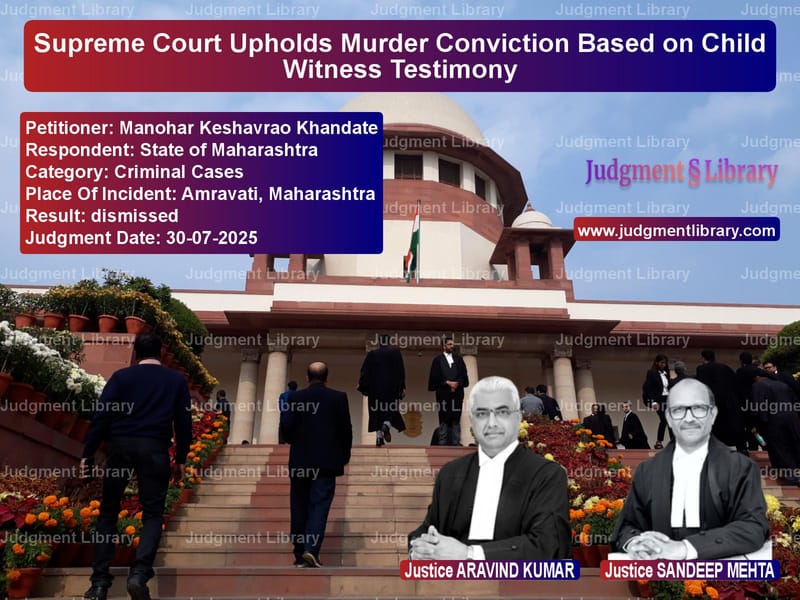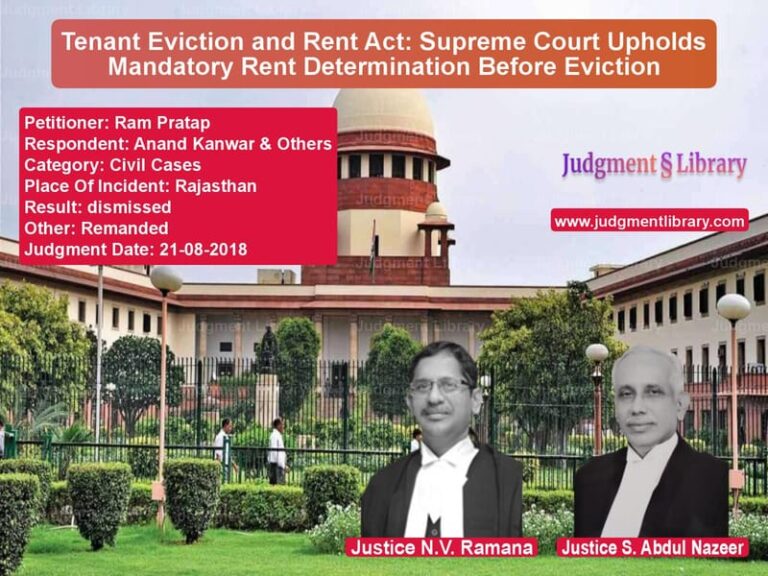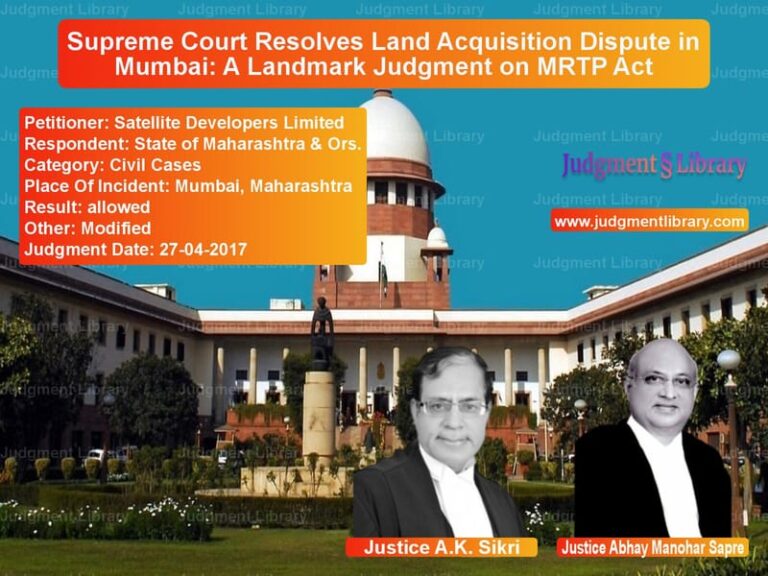Supreme Court Upholds Murder Conviction Based on Child Witness Testimony
A heartbreaking case of domestic violence that ended in murder reached its final conclusion when the Supreme Court of India upheld the life imprisonment of a man who brutally killed his wife, with the most compelling evidence coming from their own nine-year-old daughter who witnessed the crime. The case of Manohar Keshavrao Khandate vs State of Maharashtra represents a tragic story of domestic abuse that escalated to fatal violence, leaving children orphaned and a family destroyed.
The case dates back to 2006 when Ranjana, the wife of Manohar Khandate, was found dead in their home in Amravati, Maharashtra. The prosecution alleged that Manohar, who worked as a cycle rickshaw puller, regularly beat his wife after consuming alcohol, and on the fateful night, this violence turned fatal. What made this case particularly poignant was that the primary witness was the couple’s own daughter, who was just nine years old at the time of the incident.
The child witness, referred to as Ms. D in court documents to protect her identity, gave a chilling account of what happened that night. She testified that she was sleeping beside her mother when she was awakened by some commotion. When she woke up, she found her father sitting nearby her mother, who had been covered with a chaddar (bedsheet). The child’s testimony revealed crucial details that pointed to her father’s guilt.
The Supreme Court noted the significance of the child’s evidence, stating: “The child witness (PW-3), aged 9 years, gave convincing evidence stating that her father (accused-appellant) used to pull a cycle rickshaw and her mother (Smt. Ranjana) used to perform the household duties and also worked as a maid servant. Her father often beat her mother after consuming liquor.”
What made the child’s testimony particularly compelling was her description of her father’s behavior immediately after the crime. She stated that when she inquired about her mother’s condition, her father told her that her mother was not feeling well and that he would bring a doctor. However, he specifically forbade her from removing the chaddar and looking at her mother. This instruction, according to the court, revealed his guilty state of mind.
The court observed: “The accused-appellant instructed the child witness not to remove the chaddar which strongly suggests towards his guilty state of mind because he did not desire that the child should see the condition of her mother.”
After giving this evasive reply, the accused-appellant absconded from the house, never to return. The frightened child, left alone with her injured mother, eventually removed the chaddar and discovered the horrifying truth – her mother had severe bleeding injuries on her head and was not responding. The child immediately rushed to their landlord’s house for help.
The landlord, Shri Arun Bhagwantrao Khandetod (PW-1), and his wife responded immediately. Finding Ranjana unresponsive, the landlord alerted a nearby police constable and informed the police station. The police arrived at the scene, and the body was sent for postmortem examination. Crime No. 221 of 2006 was registered against the accused-appellant.
The medical evidence presented by the Medical Jurist (PW-4) established beyond doubt that Ranjana’s death was homicidal in nature, caused by blunt weapon injuries inflicted on her head. This medical evidence corroborated the child witness’s account of seeing bleeding injuries on her mother’s head.
During the trial, the defense attempted to challenge the child’s testimony by suggesting that she might have been tutored by her grandmother and maternal uncle to give evidence against her father. However, the court found these suggestions to be without merit. The judges noted that the child witness had remained unshaken during cross-examination and stood firm on her version of events.
The Supreme Court made a significant observation about the reliability of the child’s testimony: “Having thoroughly appreciated the evidence of the child witness (PW-3), we find her testimony to be absolutely natural, and she is a witness of sterling worth. The lame suggestions given by the defence to the child witness that she might have been tutored by her grandmother and maternal uncle to give evidence against the accused-appellant do not carry any weight whatsoever.”
Another crucial piece of evidence that connected the accused to the crime was the bloodstains found on his shirt. Forensic analysis revealed that the blood on his shirt matched the blood group of the deceased, thereby providing scientific corroboration to the child’s testimony.
The court also emphasized the importance of Section 106 of the Indian Evidence Act in this case. This section places the burden of explanation on the accused when the facts are especially within their knowledge. Since the incident took place within the four walls of the house where only the accused-appellant, the deceased, and their daughter were present, the burden was on the accused to explain how his wife sustained fatal injuries.
The judgment stated: “In terms of Section 106 of the Evidence Act, the burden rested upon the accused-appellant to offer a credible explanation as to under what circumstances the deceased Smt. Ranjana, sustained the fatal injuries, particularly when the incident took place within the four walls of the house where the accused-appellant resided with the deceased Smt. Ranjana.”
The accused-appellant had offered a blank denial in his statement under Section 313 of the Code of Criminal Procedure, claiming innocence without providing any alternative explanation for his wife’s death. The court found this defense to be insufficient and noted that the accused’s presence in the house at the time of the incident had been reinforced through answers solicited from the child witness during cross-examination.
One of the most compelling aspects of the case, as highlighted by the court, was the absence of any motive for the child to falsely implicate her own father in her mother’s murder. The judges noted: “The child witness had no reason whatsoever to give false evidence implicating her own father for the murder of her mother.”
The trial court had convicted the accused-appellant and sentenced him to rigorous imprisonment for life along with a fine of Rs. 5,000. When the accused appealed to the Bombay High Court, the conviction was upheld. The High Court had reappreciated the evidence and concluded that the child witness’s testimony was reliable and trustworthy, while the defense of denial taken by the accused-appellant was flimsy and unacceptable.
The Supreme Court, after thoroughly examining the evidence and arguments, agreed with the lower courts’ findings. The bench comprising Justice Aravind Kumar and Justice Sandeep Mehta stated: “It is our firm opinion that the conviction of the accused-appellant as recorded by the trial Court vide judgment dated 14th August, 2007, and affirmed by the High Court vide judgment dated 1st April, 2011, does not suffer from any infirmity.”
Accordingly, the Supreme Court dismissed the appeal, finding it devoid of merits. The court also cancelled the bail bonds of the accused-appellant, who had been directed to be enlarged on bail by the Supreme Court in 2018. The accused was directed to surrender before the concerned trial court within four weeks and undergo the remainder of his sentence. The trial court was authorized to take appropriate steps to ensure that the accused serves out his sentence if he fails to surrender voluntarily.
This judgment underscores several important legal principles. First, it reaffirms the value of child witness testimony when found to be natural and trustworthy. Second, it highlights the application of Section 106 of the Evidence Act in cases where the incident occurs within the exclusive knowledge of the accused. Third, it demonstrates how circumstantial evidence, when combined with reliable eyewitness testimony, can lead to a conviction even in the absence of direct evidence.
The case also serves as a grim reminder of the tragic consequences of domestic violence and how it affects not just the immediate victims but also the children who witness such violence. The courage shown by the nine-year-old girl in testifying against her own father, despite the personal tragedy she endured, ensured that justice was served for her mother’s brutal murder.
As domestic violence continues to be a significant problem in Indian society, this judgment sends a strong message about the seriousness with which the judiciary treats such crimes and the importance of protecting the most vulnerable members of society from violence within their own homes.
Petitioner Name: Manohar Keshavrao Khandate.Respondent Name: State of Maharashtra.Judgment By: Justice ARAVIND KUMAR, Justice SANDEEP MEHTA.Place Of Incident: Amravati, Maharashtra.Judgment Date: 30-07-2025.Result: dismissed.
Don’t miss out on the full details! Download the complete judgment in PDF format below and gain valuable insights instantly!
Download Judgment: manohar-keshavrao-kh-vs-state-of-maharashtra-supreme-court-of-india-judgment-dated-30-07-2025.pdf
Directly Download Judgment: Directly download this Judgment
See all petitions in Murder Cases
See all petitions in Domestic Violence
See all petitions in Bail and Anticipatory Bail
See all petitions in Attempt to Murder Cases
See all petitions in Other Cases
See all petitions in Judgment by Aravind Kumar
See all petitions in Judgment by Sandeep Mehta
See all petitions in dismissed
See all petitions in supreme court of India judgments July 2025
See all petitions in 2025 judgments
See all posts in Criminal Cases Category
See all allowed petitions in Criminal Cases Category
See all Dismissed petitions in Criminal Cases Category
See all partially allowed petitions in Criminal Cases Category







